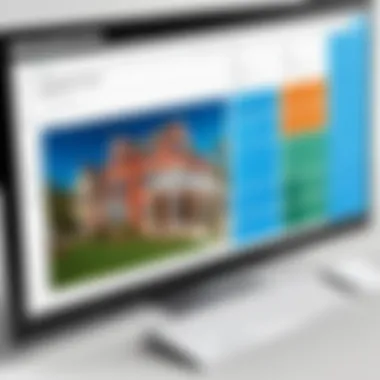Exploring Multiple Property Management Systems


Intro
Multiple Property Management Systems (MPMS) are pivotal in today's real estate market. They offer a comprehensive way to manage properties, which can be crucial for property managers who are tasked with overseeing various listings. These systems streamline numerous tasks, from tenant communications to financial reporting, ultimately improving operational efficiency. In this time, understanding the intricacies of MPMS is essential. This article presents an in-depth analysis, discussing key features, benefits, challenges, and future prospects that these systems embody.
Features and Capabilities
Overview of Key Features
Multiple Property Management Systems come equipped with a variety of features designed to address the diverse needs of property managers. Common functionalities include lease tracking, maintenance management, financial reporting, and tenant screening. Each feature caters to specific aspects of property management.
- Lease tracking allows users to monitor lease dates, renewals, and compliance.
- Maintenance management contains work order requests, scheduling, and vendor management.
- Financial reporting provides insights into income and expenses, aiding in budget planning.
- Tenant screening helps assess potential renters through background checks and credit assessments.
These features not only improve efficiency but also contribute to better tenant satisfaction and retention.
User Interface and Experience
A user-friendly interface is paramount for any technology. MPMS platforms prioritize ease of use, enabling property managers to navigate through complex tasks smoothly. For instance, dashboards typically offer a snapshot of property performance and alerts for upcoming expirations or maintenance needs.
Responsive design is also crucial; robust systems often provide mobile applications to facilitate management on-the-go. This capability ensures that managers can respond to tenant inquiries or critical issues promptly, regardless of location.
Performance and Reliability
Speed and Efficiency
The performance of a property management system largely hinges on its speed and overall efficiency. Quick load times and fast processing capabilities enhance user experience while helping property managers execute tasks without delays. A slow system can hinder productivity and frustrate users.
Maintaining efficient workflows through streamlined processes contributes significantly to operational success. Users often report higher task completion rates when the software they use is optimized for speed.
Downtime and Support
A significant consideration for adopting any software solution is its reliability. Ideally, an MPMS should have minimal downtime, ensuring that users can access the system when needed. This reliability includes robust customer support channels. Many leading systems offer 24/7 support through chat, email, or phone.
"Access to reliable support enhances user confidence in their property management systems, enabling swift resolutions to challenges that may arise."
Understanding the importance of support can influence the choice of system, as property managers must ensure that help is readily available when technical issues occur.
Finale
Understanding Multiple Property Management Systems
Multiple Property Management Systems (MPMS) are crucial in the contemporary real estate sector. As property managers oversee various properties, the complexity increases. MPMS simplifies these intricacies through consolidation and organization, enhancing workflows. This article delves into MPMS, revealing its vital factors that influence property management practices today.
Definition and Purpose
A Multiple Property Management System refers to software solutions designed to assist property managers in efficiently overseeing multiple assets. These systems provide a centralized platform that integrates key functionalities like tenant management, financial transactions, and maintenance scheduling into a unified interface. The primary purpose of MPMS is to streamline operations, which increases productivity and reduces operational costs. By collecting and processing data in real-time, MPMS ensures that property managers can make informed decisions quickly.
Historical Context
The evolution of property management has greatly influenced the development of MPMS. Traditionally, property management relied on manual processes, often causing inefficiencies and errors. As the demand for rental properties grew in the mid-20th century, the need for better management practices emerged. Innovations in technology led to the introduction of software solutions designed to aid in property oversight.
In the 1980s and 1990s, the emergence of personal computers enabled property managers to shift from pen-and-paper methods to more organized electronic records. Today, cloud-based technologies and mobile applications have transformed MPMS into comprehensive tools that empower property managers. The historical growth reflects an ongoing response to the increasing complexity of property management, aiming to enhance both efficiency and user satisfaction.
Key Features of MPMS
The functionality of Multiple Property Management Systems (MPMS) is crucial for their effective operation. A deep understanding of key features can significantly improve the efficiency and overall effectiveness of property management. These features not only streamline processes but also enhance user experience, ultimately leading to better tenant satisfaction. Below, we explore each of the essential elements that make MPMS valuable tools in the real estate landscape.
Tenant and Lease Tracking


Tenant and lease tracking is a cornerstone of any MPMS. This feature allows property managers to maintain detailed records of tenant information, lease dates, and compliance with rental agreements. By utilizing structured databases, property managers can avoid common errors such as missed payments or lease expirations. This system ensures that all critical tenant data is easily accessible and up-to-date. In the long run, accurate tenant tracking aids in reducing turnover rates and improving tenant relationships.
Online Rent Collection
The ability to collect rent online simplifies a traditionally cumbersome task. MPMS often provide tenant portals where residents can pay their rent electronically. This method is not only convenient for tenants but also ensures timely payments for property managers. Furthermore, online rent collection can help decrease the use of paper methods, supporting sustainability. Implementing such features reduces late fees and increases cash flow predictability, which is vital for budget planning in property management.
Maintenance Management
Maintenance management within MPMS provides a systematic approach to handling repair requests and maintenance schedules. Users can log issues, assign tasks to maintenance staff, and track the completion of work orders. An organized system leads to quicker response times, which can significantly enhance tenant satisfaction. Additionally, property managers can analyze maintenance trends over time, helping them allocate resources more efficiently and plan for future needs.
Reporting and Analytics
Reporting and analytics capabilities allow property managers to gain insights into their property portfolios. This feature enables the generation of financial reports, occupancy rates, and maintenance costs. Such data-driven insights are essential for making informed decisions that can impact profitability. By utilizing advanced analytics, property managers can spot trends, optimize operations, and ultimately drive better business outcomes.
"Data informs strategy; analytics ensure execution."
Benefits of Implementing MPMS
In today's complex real estate environment, the implementation of Multiple Property Management Systems (MPMS) is not merely advantageous but essential. These systems deliver insightful operational frameworks that address the intricacies of managing multiple properties. Various benefits arise from MPMS adoption, specifically enhancing efficiency, promoting clearer communication, and optimizing financial management. Understanding these facets is vital for stakeholders aiming for sustained success in property management.
Operational Efficiency
The backbone of every successful property management operation is efficiency. MPMS contributes significantly in this area by automating routine tasks. For instance, automated tenant communications, reminders for rent collection, and maintenance requests streamline day-to-day operations. Property managers can allocate time and resources more effectively.
According to recent studies, organizations that implement MPMS report up to a 30% reduction in operational costs. Automation minimizes human error and enhances productivity, allowing for a smoother workflow across different properties. With a centralized system, inventory management, and reporting are simplified as well. This structured approach allows quickly addressing issues while maintaining an organized operation.
Enhanced Communication
Communication is crucial in property management, given the need to coordinate between tenants, landlords, and maintenance personnel. An effective MPMS improves these interactions by facilitating clear channels of communication. Tenant portals are a key feature of many systems, giving tenants easy access to important information like lease agreements and payment history.
Furthermore, the MPMS enhances communication among staff by keeping everyone informed about ongoing issues and updates. For example, through cloud-based functionalities, information is readily available to all relevant parties without delay. This immediate access reduces misunderstandings and ensures that all stakeholders are on the same page, which is critical in preventing conflicts and fostering a cooperative environment.
Improved Financial Management
Financial management is a critical aspect that separates successful property management firms from the rest. With MPMS, tracking income and expenses becomes less cumbersome. The system provides real-time data on cash flow, helping managers make informed decisions. For instance, landlords can analyze payment histories and predict financial trends that may arise.
The integration of analytical tools allows property managers to identify where they can cut costs or where they might need to allocate more resources. The reporting features often available can generate financial reports at the snap of a finger, which aids in budgeting and audits. This level of oversight ensures that financial resources are managed effectively, ultimately contributing to better profitability.
"In the dynamic world of real estate, the capabilities of MPMS transform how property managers operate, enhancing both efficiency and clarity in communication."
In summary, implementing MPMS is integral to optimizing property management operations. The boost in operational efficiency, enhanced communication, and refined financial management underscores the value these systems bring to property managers and investors alike.
Challenges Associated with MPMS
Understanding the challenges associated with Multiple Property Management Systems (MPMS) is critical for property managers and stakeholders. While these systems offer several advantages, their implementation can also bring complexities. Addressing these challenges early in the decision-making process can significantly enhance the likelihood of successful adoption, ensuring effective operation.
Integration with Existing Systems
Integrating an MPMS with existing systems is a common hurdle that many organizations encounter. Organizations often utilize legacy software or various applications that serve different departmental needs. Integrating a new MPMS with these systems can result in complications.
- Compatibility Issues: Not all MPMS solutions are built to easily integrate with older platforms. Property managers may face costly investments in updates or replacements for existing systems.
- Data Migration: Transferring data from legacy systems to a new MPMS may lead to inconsistencies or losses. It is crucial to conduct a thorough assessment of the current data structure before migration.
- Workflow Disruptions: During the integration process, business operations may experience interruptions. This can lead to delays in functions like tenant management or financial reporting.
Data Security Issues
Data security poses a significant challenge when adopting an MPMS. As property management involves handling sensitive information, like financial details and personal data, the risk of breaches can have severe consequences. Here are key points to consider:
- Risk of Cyberattacks: A new system can become a target for cybercriminals. Organizations need to ensure that their MPMS has robust security measures in place.
- Compliance Regulations: Depending on geographical location, organizations must adhere to regulations regarding data protection. Non-compliance can lead to penalties and loss of customer trust.
- Regular Updates and Maintenance: Continuous maintenance is necessary to protect against vulnerabilities that may arise over time. Failing to update software can leave systems open to attacks.


User Adoption and Training
User adoption and training present another challenge when implementing an MPMS. Having the best system does not guarantee success if staff members are not comfortable using it. Key considerations include:
- Training Requirements: Introducing a new system often requires extensive training for users. Property managers should allocate adequate time and resources to ensure all staff understand the system's functionalities.
- Resistance to Change: Employees may resist the transition from familiar systems to new ones. Addressing concerns through effective communication is vital.
- Ongoing Support: Providing users with ongoing support and resources can enhance their proficiency. This can lead to improved efficiency as they adapt to the new system.
Comparative Analysis of Leading MPMS Solutions
A thorough comparative analysis of leading Multiple Property Management Systems (MPMS) is essential for property managers. It allows for an informed decision when selecting a system that best meets their needs. The market has diverse solutions, each offering unique functionalities, pricing structures, and target user bases. Understanding the strengths and weaknesses of each option can lead to better efficiencies, enhanced service delivery, and optimal return on investment.
System A Overview
Key Features
System A has a robust set of key features that enhance its usability. One of its standout characteristics is the comprehensive tenant tracking capability. This feature streamlines the management of tenant information, lease agreements, and payment histories. The added functionality of automated reminders for rent due dates reduces late payments, providing a consistent cash flow for property managers. However, the sheer volume of features can sometimes overwhelm new users.
Target Users
The primary target users of System A include both small property management firms and larger corporations. Its user-friendly interface makes it particularly attractive for smaller businesses looking to efficiently manage less complicated portfolios. Large firms may also find its expansive features useful, though they might need additional training to leverage full capabilities. This dual appeal makes System A a favorable choice.
Pricing Structure
System A offers a tiered pricing structure, which can cater to various budgets. The base plan is competitively priced, appealing to startups and smaller stakeholders. Advanced features, however, are locked behind higher pricing tiers. This can be a barrier for some, as the overall investment can increase significantly if opting for higher level access.
System B Overview
Key Features
Unlike System A, System B focuses significantly on online rent collection. The platform supports various payment methods, including credit cards and direct bank transfers. This flexibility encourages timely payments from tenants. The unique feature of real-time payment tracking provides valuable insights into cash flow status. However, some users report connectivity issues that hinder timely transactions.
Target Users
System B primarily attracts mid-sized property management firms. Its emphasis on online payment solutions resonates with users looking for efficiency and convenience. Owners of multiple properties often choose System B to facilitate seamless payment processes. Although it is not as suitable for very large firms due to a lack of extensive reporting features, its specialization suits its audience well.
Pricing Structure
The pricing structure of System B is based on a flat monthly fee, which covers access to most features. This predictability is beneficial for budgeting purposes; however, some users find the fee relatively high for the level of service provided. Custom pricing models could enhance appeal for diverse users.
System Overview
Key Features
System C stands out with its comprehensive reporting and analytics features. The built-in dashboard allows property managers to visualize data effortlessly, making it a powerful tool for strategic decision-making. Unique to System C is its predictive analytics, which can forecast potential income based on historical data. However, users may require training to fully exploit these analytical capabilities.
Target Users
The target users for System C include property managers focused on investment and risk assessment. Its strong data-driven approach attracts firms that prioritize financial insights. However, smaller management companies may find it overly complex for their needs, making it less popular among less experienced users.
Pricing Structure
The pricing for System C is notably higher. This premium is justified for firms that can leverage its advanced features effectively. Flexible payment plans are available, enhancing accessibility for larger firms. Nevertheless, this higher pricing may discourage smaller property managers.
The right MPMS can transform the property management operations, contributing to both operational efficiency and financial performance.
Implementation Strategies for MPMS
Implementing a Multiple Property Management System (MPMS) is not just a technical exercise; it is a strategic move that can significantly affect the operational dynamics of property management. Proper implementation strategies ensure that organizations choose the right system, customize it according to their needs, and deploy it effectively within the organization. Each of these steps comes with its own set of considerations, benefits, and challenges. This article section will delve into why these strategies are crucial and how they set the stage for successful MPMS utilization.


Needs Assessment
A needs assessment serves as the foundation for any MPMS implementation. It starts with determining the specific requirements of your organization. This process involves analyzing the current systems and workflows in place. Engage stakeholders at all levels, from upper management to property management staff. Their insights are valuable for identifying inefficiencies and gaps in the current setup. Typical aspects to consider include:
- The size of your property portfolio.
- The types of properties being managed.
- Current challenges faced with manual processes.
- Desired features for future MPMS capabilities.
Conducting surveys or interviews can help clarify needs. A comprehensive needs assessment informs decision-making and guides the selection of features that will provide real benefits.
Choosing the Right System
After establishing the needs of the organization, the next step is to select the right MPMS that aligns with these requirements. There are many available systems, each having its unique features and pricing structures. Key considerations for this selection process should include:
- Scalability: Can the system grow with your business?
- Integration capabilities: How does it work with existing software?
- User experience: Is it easy to navigate for all users?
- Customer support: What assistance is available post-implementation?
Each of these factors can drastically affect user adoption and overall satisfaction with the system. It’s critical to involve your IT department during this stage to ensure technical compatibility and support capacity.
Planning the Rollout
Once the system is chosen, planning the rollout is essential. A well-structured deployment plan can mitigate issues that may arise during the transition from old systems to the new MPMS. In this phase, consider the following components:
- Timeline: Define a clear project timeline, including phases for tasks like user training and software configuration.
- Training Programs: Develop comprehensive training sessions tailored to different user groups, ensuring everyone feels confident using the new system.
- Data Migration: Create a strategy for migrating data from old systems to the new MPMS. This process should include data cleansing to remove any outdated or incorrect information.
- Feedback Mechanism: Establish channels for receiving user feedback post-implementation to identify any lingering issues or needed adjustments.
Effective planning also includes risk management strategies. Anticipate challenges, such as resistance to change or technical issues, and have contingency plans in place. With thorough planning and execution, the rollout can go smoothly and set the stage for long-term success.
Future Trends in MPMS Development
The landscape of property management is evolving rapidly, driven by advancements in technology and the growing demands of property managers. Future trends in Multiple Property Management Systems (MPMS) are not just ancillary elements; they represent essential shifts that can greatly enhance operational efficiency and responsiveness. Understanding these trends is crucial for stakeholders seeking to maintain a competitive edge in the real estate sector.
Artificial Intelligence Integration
Artificial Intelligence (AI) is making significant inroads into MPMS, revolutionizing how property managers operate. Through AI-driven analytics, systems can predict maintenance issues before they arise, enabling proactive rather than reactive management. This technology can also be utilized for enhanced tenant screening, ensuring that property managers select reliable tenants, thus reducing the risk of late payments or eviction. Moreover, AI-powered chatbots enable real-time communication between tenants and property managers, providing instant responses to inquiries and improving overall tenant satisfaction. With these capabilities, integrating AI not only streamlines processes but also enhances decision-making.
Mobile Accessibility
In today's fast-paced world, mobile accessibility has become a non-negotiable requirement for property management systems. Professionals are increasingly on the move, and the need for mobile-friendly platforms is paramount. MPMS that support mobile operations allow property managers to access critical data anywhere and anytime. This includes reviewing lease agreements, tracking maintenance requests, and communicating with tenants all from a smartphone. Additionally, tenants benefit from mobile access, allowing quick bill payments and maintenance requests through dedicated apps. This accessibility not only boosts productivity but also improves tenant engagement and satisfaction, which is essential in a competitive marketplace.
Sustainability Features
The growing concern for environmental sustainability is influencing multiple sectors, including property management. Sustainability features in MPMS can be a definite competitive edge. Systems that offer tools for tracking energy usage, waste management, and sustainable materials in property renovations help landlords and managers meet both legal requirements and ethical standards. These tools support not only compliance with local regulations but also position the properties as more attractive to eco-conscious tenants. By integrating features focused on sustainability, property managers can enhance their brand image while contributing to broader environmental goals.
"The future of property management lies in adapting to technological advances and meeting tenant expectations for sustainability and accessibility."
The trends discussed above are not hypothetical; they represent the realities that will shape the future of MPMS. Stakeholders must pay careful attention to these developments to remain relevant in an ever-changing landscape.
Epilogue
The conclusion of this article is crucial as it encapsulates the insights gained from an in-depth analysis of Multiple Property Management Systems (MPMS). Revisiting significant points made throughout this article helps to solidify understanding and provides a clear path forward for readers.
Summary of Key Points
Throughout the discussion, several key elements of MPMS emerged as pivotal:
- Definition and Purpose: MPMS are designed to streamline operations in property management, offering a comprehensive toolbox for managing multiple properties efficiently.
- Key Features: Essential features such as tenant and lease tracking, online rent collection, maintenance management, and reporting tools serve as the backbone of any effective system.
- Benefits: Implementing MPMS leads to enhanced operational efficiency, better communication among stakeholders, and improved financial oversight, crucial for long-term success in property management.
- Challenges: Integration complexities with existing systems, potential data security issues, and the necessity for user training must be addressed to maximize the systems' potential.
- Future Trends: Advancements such as AI integration, mobile accessibility, and sustainability features highlight the ongoing evolution of MPMS.
These points encompass the broader narrative of how MPMS can transform real estate operations, enabling property managers to make informed decisions that drive growth and success.
Final Recommendations
In light of the findings discussed, several recommendations can optimize the implementation and utilization of MPMS:
- Conduct a Needs Assessment: Evaluate your specific requirements to choose a system that aligns with your business model and goals.
- Prioritize Training: Ensure thorough training is provided for all users to facilitate smoother adoption of the system.
- Emphasize Integration: Focus on selecting systems that can easily integrate with existing software to minimize disruptions.
- Stay Informed on Trends: Keep up with emerging technologies and updates within the MPMS landscape to maintain a competitive edge.
- Test and Iterate: Implement a trial phase to identify any challenges early on, allowing for adjustments that can enhance system effectiveness.
These recommendations position property managers and stakeholders to maximize the advantages of MPMS, securing their role in a rapidly evolving real estate market.







